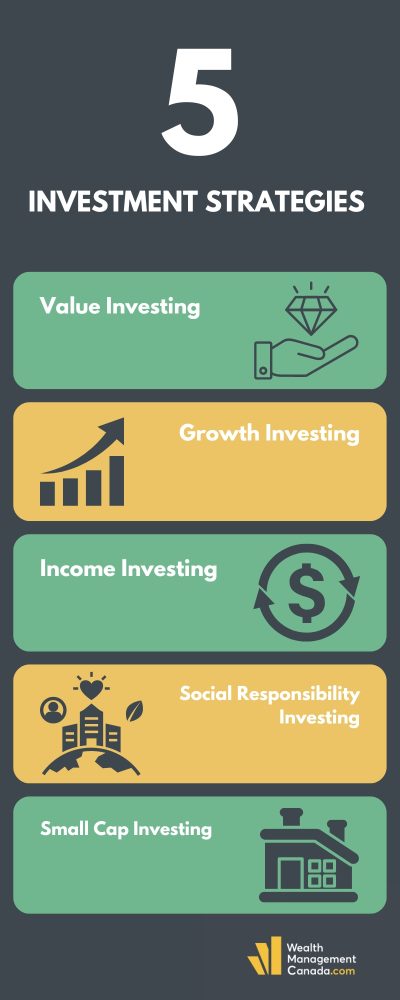There are a thousand ways to slice and dice an onion; and a thousand ways to invest your money, too. But while you could pick from hundreds of different stocks, bonds, properties, savings accounts, cryptocurrencies, or startups to invest in, you’ll notice the manners of investment feel similar. That’s because there are a few investment strategies Canada sees across investors. On top of that, people’s different personalities could inform their investments, too.

Table of contents
If you’re curious about ways to invest and protect your wealth, a wealth manager can walk you through all your options. In the meantime, it’s helpful to learn about the investment strategies available to you. We’ll give you the lowdown on different types of strategies with this article.
What are investment strategies?
How did you decide to invest in that cannabis stock? What made you buy that fixer-upper property down the road? Or what’s stopping you from investing your entire inheritance into a startup? You have your goals and values, both of which guide investment strategies.
Your strategy might be informed by:
- Risk tolerance
- Growth goals
- Personal values
- Affordability and access to capital
- Short-term and long-term goals
Let’s look at some specific investment strategies in Canada and beyond.
Related Reading: Best Wealth Management Books for Canadians

Types of Investment Strategies in Canada
Think about what you want out of your investments. Do you want a growing portfolio to leave to your kids one day? Or maybe you want an investment that generates regular, passive income.
Pretty much every financial goal you could have is covered by an investment strategy in Canada. But don’t get tied down by them, either. You can shift your investment strategy based on changes in your income and capital, long-term financial goals, and even your personal preferences. For example, a small-cap investor might grow older and prefer a more risk-averse investment like blue chip stocks via a growth investment strategy. But let’s dive into the different investment strategies commonly seen in Canada.

START WORKING WITH A WEALTH MANAGER NOW
Value investing
Ever notice a stock that feels astronomically expensive? Take Apple, for example, priced at $184 per share. The market says that’s what it costs — but how much are they actually worth? Experts predict less than half, at around $75.
Sometimes, the market doesn’t always catch a company’s true value. This is the difference between market and intrinsic value. In Apple’s case, its market value is seriously inflated. But that notoriety makes it more of a growth stock than a value stock, but more on that later.
Still, market value could actually be understated for other companies. This is the core of value investing. Here, an investor using value investing would purchase shares of a company that has a much lower market value than intrinsic value. Often, these companies are relatively new and on the rise so the market hasn’t priced them according to their true value yet. The strategy bets on the market correcting itself, which always happens eventually. Then, their smaller initial investment becomes much higher when the price per share skyrockets.
This strategy is for long-term investors like Warren Buffet, CEO of Berkshire Hathaway. How does he know if a company has a higher intrinsic value? Strong indicators include evidence of competitive advantage, regular profits, and a healthy balance sheet with proportional assets-to-debt ratios.
Examples of value stocks:
- Canadian Tire
- Tourmaline Oil
- Gildan Activewear
Growth investing
Growth investing is a strategy where investors choose companies that have high growth potential. We know; that sounds similar to value investing. So what’s the difference?
Competitive advantage is one similarity, but here, you’re looking at stocks expected to surpass other industry competitors based on strong performance history and price increases. Furthermore, growth investing might actually consider companies with higher market values and fluctuations, which isn’t the case with value investing. In addition, the focus is on the prediction for high growth, not higher value compared to market value as we see with value investing.
Here are a few more characteristics of growth stocks:
- Large target market and audience
- Strong leadership with experience, results, and credentials
- Growing industry in general
- Consistent sales growth
Growth stocks have a slightly higher risk meter, with investors looking for both short-term and long-term growth and returns.
Examples of growth stocks:
- Alibaba
- Amazon
- Adobe Inc.

START WORKING WITH A WEALTH MANAGER NOW
Income investing
Calling all passive income aficionados — income investing is your cup of tea. You’re not looking for your stocks to increase in value; at least, that’s not your top priority. An income investor wants to create an investment portfolio that provides a consistent, stable source of income.
We’re talking dividends, interest, or even rental income, if we’re talking about the housing market or REITs. When choosing income-investing stocks, always check the dividend yield. If you can’t see this, you can calculate it by dividing the annual dividend payments per share by the stock price. You’ll usually receive dividends every quarter, but it depends on the entity.
Real estate rentals are a popular income investing model, but you don’t actually have to purchase a physical property to get that income. REITs, or real estate investment trusts, are companies that invest in large-scale real estate projects and pay out dividends to every investor.
Examples of income stocks and investments:
- RIOCAN Real Estate Investing Trust
- Multifamily rental property
- Dream Industrial REIT
Socially responsible investing
That new vape company or cannabis stock might bring shareholders massive returns — but at the cost of lung issues and tobacco or marijuana addiction in customers. For some, the investment value might not make up for unaligned personal values.
Enter socially responsible investing (SRI), an investment strategy that places an investor’s morals up top with investment potential. You might have it heard it referred to as ESG investing — Ethics, Social, and Governance considerations for investments. A socially responsible investor won’t touch anything that goes against their values.
For example, an environmentally conscious investor might consider investments in big-box stores unethical, due to their immense waste. Similarly, someone who values human rights might not invest in large retailers that propel wage disparity in developing countries.
Yes, values come above profits here. But is that realistic for investing? Again, yes — experts predict ESG investing to increase by 22% by 2026. Stock marketplaces like WealthSimple offer a tailored SRI service that invests users’ funds across stocks that:
- Have at least 25% or 3 women on the company board of directors
- Aren’t part of the top 25% carbon-emitters of their respective industry
- Aren’t part of a “problematic” industry like oil or guns
Examples of socially responsible investments:
- Vanguard ESG ETF
- Nuveen
- Pax Elevate Global Women’s Leadership Fund
Small-cap investing
How much is a company’s total market value of all their outstanding shares? That’s known as market capitalization. Small-cap investing is a strategy that prioritizes investments in companies with relatively low market capitalization, between $250 million and $2 billion.

START WORKING WITH A WEALTH MANAGER NOW
Examples of small-cap investments and stocks:
- WELL Health Technologies
- Birchcliff Energy
- HIVE Blockchain Technologies Stock
Despite smaller capitalization, small-cap investments are historically known to yield greater returns and have higher growth potential.
Still, the potential for profits come at the cost of higher risk and volatility. Why? Because the smaller capitalization makes them more vulnerable to extreme market events. These companies have lower liquidity, along with less information and history available for investors.
Consider this: a blue chip, large-market cap stock like Coca-Cola, with a long history of profits, is much more likely to survive a recession than a small-cap stock.
Related Reading: How to Invest in Private Equity
Choosing the Best Investment Strategy for You
The best investment strategy for you depends on, well, you! Sit down and consider what you want out of life and your investments. If you’re looking for long-term growth and aren’t interested in quick wins, a value investing strategy could be for you.
And if you have a high risk tolerance and want to make a quick buck? You might try a small-cap investment — just be prepared for the risk that comes with it.
No matter which investment strategy resonates, you might need some help planning your next steps. That’s where a wealth manager comes in. Here at Wealth Management Canada, we pair hundreds of Canadians like you with a dedicated, certified wealth manager.
Ready for your investment strategies in Canada to thrive? Find a wealth manager today!
Read More: Understanding ‘Investing Styles’ and How to Make Them Work for You